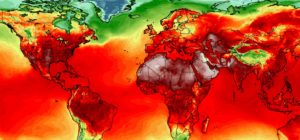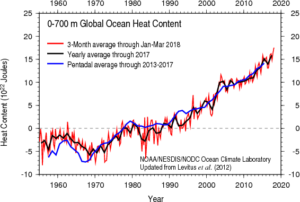
The Think Progress article, Global warming ‘double whammy’ may be steering Florence into the Carolinas, says researcher by Joe Romm (9/12/2018) makes the connection.
The path of Florence has been extremely unusual. As Philip Klotzbach, an Atlantic hurricane expert, tweeted on Friday, “33 named storms (since 1851) have been within 100 miles of Florence’s current position. None of these storms made US landfall. The closest approach was Hurricane George (1950) — the highlighted track [in white].”
Florence, tragically, has made a beeline toward the Carolinas. And it clearly was steered away from the historical (or “climatological”) path by a major high-pressure system blocking its typical path — north and away from land.
Back in 2016 Francis published a study on the link between blocking highs and global warming. At the time, she told ThinkProgress: “Our new study does indeed add to the growing pile of evidence that amplified Arctic warming and sea-ice loss favor the formation of blocking high pressure features in the North Atlantic. These blocks can cause all sorts of trouble…”
There are more details in the well cited article. Sustainabilitymath posted about hurricanes last year, Are We Seeing More Hurricanes in the North Atlantic?, which inlcudes a link to hurricane data.









